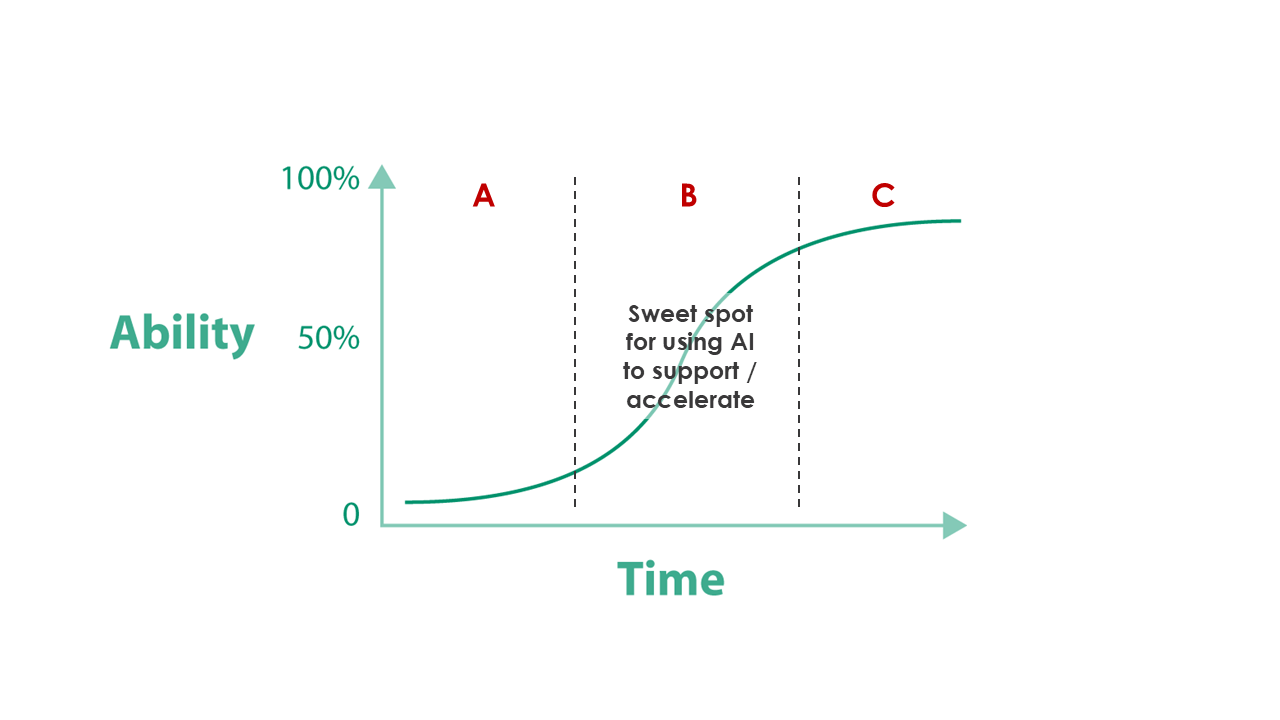While uncertainty and change present an array of challenges for today’s leaders, a less obvious one is the need to coach for confidence.
Confidence – the inner belief by an individual in their capacity to successfully meet the demands of a performance situation – is an ephemeral quality or state of mind. It’s difficult to observe, quantify or measure, and yet it’s an undeniable performance enabler. When people are confident, they can more fully express their capabilities, and are more willing to make decisions, innovate and take calculated risks.
When the New Zealand men’s National Curling Team undertook a largely self-funded move to Calgary, Alberta to enhance their preparation for the 2024 World Championships, they encountered a frustrating obstacle: rental housing was scarce and expensive. Cassandra Murray, a Retirement Living Consultant with Chartwell, one of Canada’s largest owner-operators of retirement residences, saw their appeal for help on social media and reached out with an offer: the team could stay at the Chartwell Colonel Belcher retirement village during their 2-3 month stay.
Now, having a group of young athletes sharing a living space with a group of retirement residents is not without its risks, but Cassandra saw an opportunity that she was confident could provide huge benefits for all involved. The outcome was not only a heartwarming story, but a win for the team, the residents, the staff and the organization.
 Three-quarters of the New Zealand men’s national curling team in 2023.
Three-quarters of the New Zealand men’s national curling team in 2023.
And that’s the key thing. When we are truly confident, we think win-win. When we lose confidence, we play not-to-lose.
What follows are two practical approaches that we have seen effective leaders use to support the confidence of their people as they navigate change:
01.
Clarify strengths AND how to apply them in the new environment.
02.
Focus on progress, not perfection.
Clarify strengths AND how to apply them in the new environment
During times of significant change, people sometimes lose sight of their strengths or are unsure of how to apply them in new circumstances. As a leader, you may not have all the answers about how things will operate in the future, but you can help your team regain a sense of direction by reconnecting them with their core strengths and how to leverage them in a new environment.
Start by revisiting familiar ground. Encourage your team members to reflect on their past successes and identify the strengths that contributed to those achievements. Ask them specific questions that prompt introspection:
- Where have you been most successful in your current role?
- What skills or abilities helped you achieve those outcomes?
By guiding them through this process, you help them rebuild a foundation of confidence based on what they already know about themselves.
Once individuals have reconnected with their strengths, the conversation should then shift to the new environment. Discuss how their roles are changing, what challenges they anticipate, and what aspects of the new setup feel most daunting. From there, work together to identify ways their existing strengths can be applied to these new challenges. This process of translation—helping individuals see how their strengths remain relevant—creates a bridge between the past and the future.
Focus on progress, not perfection
The second coaching tool you can apply is to help people see progress. A proven track record of accomplishments is a huge source of confidence to rebut doubts, fears and voice of your inner critic. One of the challenges we face when we go through significant change is that we lose that track record. We’ve been successful in the environment and conditions of the past – but have a blank slate moving forward. And so, building a new track record becomes vital.
Start by creating a roadmap that identifies where they want to be six months or a year down the road, and then add-in markers of progress along the way. When our founder, Dr. Peter Jensen, works with a team one of the first things he does is create a visual staircase in which the bottom is the current moment, the top is the target (e.g., “Make the Paralympic team” or “win an Olympic Medal”) and the individual stairs are the key milestones. These can be skill-building initiatives, for example holding week-long winter training camp, or important accomplishments, such as finishing in the top 2 at a qualifying tournament.
It is remarkable how often high performers take for granted how much they know and have learned along the way. The goal for the coach is to highlight that growth and make it visible to the performer.
Once the staircase has been created, get them moving forward with a singular focus on the next step. The smaller the better. When a technical expert with a large US wealth management firm described how she got seasoned investment advisors to be comfortable using Zoom technology for client meetings during the Covid-19 pandemic, she replied “one meeting per day”. She scheduled a daily 15-minute zoom meeting with some of her veteran advisors to get them comfortable being onscreen and to allow them to play around with the technology in a safe, non-judgmental environment.
The value in having the overall framework is twofold. First, it helps the individuals embrace a learning mindset. Peter often reminds teams that “we’re going back to school” and that the key objectives are learning, practice, and improvement – all of which are under our control.
Second, having the roadmap allows the coach to periodically help the individuals and team step back and connect with the progress they have made. This can be particularly useful during a tough slog when it feels like nothing is getting done, or when a set-back occurs to help the team get past the disappointment by reminding them of how much has already been accomplished. It is remarkable how often high performers take for granted how much they know and have learned along the way. The goal for the coach is to highlight that growth and make it visible to the performer.
In Summary
Confidence is essential to sustaining courage through change, but confidence is ephemeral – and building it can be tricky: coaching for confidence requires empathy and a willingness to meet people where they are. With a twin focus on helping people see how their strengths can be applied in a new environment, and helping them connect with progress and small wins as they adapt, you can help them remain the bold, adaptable go-getters you know them to be.
At Third Factor, we’ve spent over four decades working at the intersection of business and sport. Our programs have always been shaped by the high-performance principles used by Olympic coaches, elite athletes, and championship teams. Today, we’re proud to deepen that connection with the formation of our Sport Advisory Board—a small, purpose-driven group of leaders who are shaping the future of sport. The Sport Advisory Board is an extension of our deep involvement in sport, and our philosophy that we find the best ideas by cross-pollinating ideas across different domains. It will help ensure that our offerings in the corporate world stay grounded in the latest insights from high-performance environments. Just as importantly, it provides a space for these sport leaders to access our coaching, consulting, and facilitation services to support their work developing athletes, teams, and organizations. We’re honoured to introduce the inaugural members of the Third Factor Sport Advisory Board:Mel Davidson

Debbie Low

Jesse Lumsden

Tracy Wilson

Drawing inspiration from “The Coach’s Coach”
Dr. Peter Jensen has been known for decades as “the coach’s coach.” Over 35 years, his focus has been on empowering coaches rather than stepping into their shoes. He works to help them improve their craft and support their teams more effectively, offering guidance, insights, and tools to help them reach their potential. His role isn’t to be the head coach, but instead to act as a mentor and resource for those who are. This philosophy guided us as we considered the potential of AI in leadership and coaching development. What if every leader had access to an AI-powered coach in their pocket—one they could turn to for advice, guidance, and practice whenever they needed it? This vision drives our integration of AI as a tool that complements and supports, rather than competes with, human coaches.Understanding AI’s role in the learning curve
The learning curve is a familiar concept in skill development. It illustrates how people acquire new skills over time, beginning with an initial uncomfortable phase of struggle and slow gains, progressing through steady improvement, and then hitting the final grueling ascent to achieve true mastery. AI’s role is most valuable in the intermediate stages, where learners have built a foundation and consistent practice and support can help them to make big leaps up the curve.
High touch to learn
At the beginning of the learning curve, learners are stepping into unfamiliar territory, and progress can be slow and frustrating. At this stage, motivation, encouragement, and a safe environment to make mistakes are critical. This is where the presence of a human coach is indispensable. Human interaction provides the emotional support and expert guidance that learners need to build confidence and take those first steps.“The goal of this high-touch phase is to equip learners with a solid foundation and prepare them to apply their new skills independently.”For example, in our 3×4 Coaching program, leaders regularly report discomfort with delivering corrective feedback and therefore delay or outright avoid it. In the classroom, we are able to set them up in pods with their peers and, through a triad exercise, show that giving “negative” feedback can be a positive, developmental experience. With the encouragement (and accountability) of their peers, participants take the first steps up the learning curve and start to build confidence. This is not much different than learning to ride a bicycle. Initially, the learner needs someone to hold the bike steady, provide feedback, and offer reassurance. This hands-on support is essential for achieving balance and overcoming the fear of falling. Similarly, in leadership development, learners benefit greatly from in-person workshops or coaching sessions where they can practice new skills, ask questions, and receive real-time feedback. The goal of this high-touch phase is to equip learners with a solid foundation and prepare them to apply their new skills independently.
High tech to transfer
As learners move past the initial hurdles, they enter the middle phase of the learning curve. This is the growth phase, where they’ve gained a basic understanding but need consistent practice to refine their skills and build confidence. At this stage, AI can play a crucial role in supporting learners’ development. AI tools excel at providing scalable, consistent support during this phase. They can simulate real-world scenarios, offer constructive feedback, and serve as a resource for learners to practice and refine their skills. Our pilot programs have confirmed the value of this approach. Leaders who have used our AI tools report that these tools help them apply what they’ve learned in their training programs. For example, our AI tools have been instrumental in helping leaders simulate coaching conversations, deliver feedback effectively, and prepare for performance reviews. By practicing in a non-judgemental, low-stakes environment, they gain confidence and improve their skills before applying them in real-world situations.AI as sustainment
AI is particularly effective at supporting sustainment. To understand this, it’s helpful to distinguish between two types of motivation in the learning process: the motivation to learn and the motivation to transfer.“People are motivated to learn when they encounter new ideas, engaging experiences, or compelling stories.”The motivation to learn is rooted in intellectual curiosity. People are motivated to learn when they encounter new ideas, engaging experiences, or compelling stories. This type of motivation often requires a human touch—someone who can inspire and captivate learners, sparking their interest in the subject matter. These are areas where human coaches excel. They can create dynamic, interactive learning experiences that draw learners in and motivate them to engage with new concepts. The motivation to transfer, on the other hand, is about applying what has been learned in a real-world context. This requires an environment where learners feel supported and confident in their ability to succeed. Motivation to transfer comes from having access to resources, someone to turn to for advice, and a sense of accountability. These are areas where AI shines. By providing tools and guidance for application, AI helps learners bridge the gap between theory and practice. AI can simulate coaching conversations, offer tailored feedback, and provide reminders to keep learners accountable to their goals. It creates an environment where learners can experiment, refine their skills, and build confidence in their abilities—all while supporting their long-term growth.
The future of coaching
The integration of AI into coaching enhances rather than replaces the role of human coaches. While human coaches inspire curiosity, build foundational skills, and connect on a personal level, AI excels at providing scalable, consistent support during the critical growth phase of skill development. This complementary relationship allows learners to benefit from both personalized guidance and accessible tools for practice and refinement. By blending the strengths of human connection and technological capability, we create a sustainable, accessible coaching model. Human coaches can focus on motivation and expertise, while AI supports learners in applying and mastering new skills. This balanced approach ensures coaching remains effective and widely available, fostering a culture where both learners and coaches thrive in an evolving landscape.New manager development programs are often a surprising “problem child” in the Learning & Development portfolio.
The recent Association for Talent Development (ATD) report sponsored by Third Factor, “New Manager Development: Building a Foundation for the Future,” highlights a critical gap: while 70% of organizations have new manager development programs, most fail to realize their full potential with 77% reporting only moderate success or worse.
Helping new managers transition from individual contributor to people leadership roles is vitally important for the performance of not only those managers but everyone that reports to them as well. But with the large population of managers in most organizations, Learning & Development (L&D) is often tasked to execute these programs at scale and on a shoestring budget. Add in the time pressures on new managers, and it can feel near impossible to deliver impactful leadership development programs for this audience.
We know how challenging this mandate can be, so we’ve collected some practical strategies from leading organizations that we partner with to help get the value out of your investment in new manager development.
Leadership at the Helm: Building Top-Down Support
The ATD report underscores the importance of senior leadership in new manager development. Most of the organizations surveyed indicated that a lack of either resources, senior leadership support, and/or prioritization were challenges to training new managers. So how do you build that critical support at the top of the house?
01.
Pick your moment and leverage business needs to advance new manager training.
02.
Enlist your partners to sell your vision for new manager training internally.
03.
Get senior leaders directly involved in training to underscore its importance.
First, pick your moment. When organizations make significant investments in new manager development, it typically comes at a time when there is a clear business need – for example, a new strategy, a culture transformation, declining engagement scores, or high turnover. Use these windows of opportunity to demonstrate how Learning & Development can help turn conceptual business plans into real action by driving the right behaviors in managers.
Second, enlist your partners. You need every tool in your arsenal to build the strongest business case to senior leaders for investing in new manager development. Involve HR or internal business partners as well as your third-party vendors to help demonstrate to senior leaders the value and expected outcomes of these programs. Hearing directly from your leadership team about a strategic transformation they are driving from transactional to advisory services, for example, will enable your vendors to design programs that directly support those needs.
Finally, start small and get senior leaders directly involved. One L&D team that we work with is driving a multi-year rollout of a two-day in-person program to help managers build coaching skills – a significant investment of time and resources. But it all started with just one session focused on the C-Suite team. Through that firsthand experience, the CEO and his team became passionate champions of the program. They not only committed to funding a broad program rollout, but the CEO now speaks directly to every cohort of managers that goes through the program. His involvement sends a strong message about his commitment to manager development and also reinforces the connections between the content and their business priorities.
Balancing Learning Formats
Training a large population of new managers can be costly. For many organizations, it’s just not feasible to offer in-person experiential learning programs to all new managers.
In fact, the ATD report notes that asynchronous learning channels are the most common offering made available to new managers. We often hear from L&D leaders about the benefits of asynchronous learning for creating custom learning pathways and offering flexible programs that work around the busy schedules of new managers. Yet there is always a desire to incorporate some of the benefits of live, in-person learning experiences as well.
Increasingly, organizations are looking at blended learning formats to provide the scale and cost effectiveness of asynchronous learning but with some of the human connection and energy of live or in-person programs.
A financial services company that we partner with offers an asynchronous program that enables managers to learn coaching skills through a series of self-paced videos. But to enhance the experience through peer support and live discussions, managers are placed into learning cohorts that proceed through the program as a community. A live virtual kickoff provides context about the program, introduces managers to others in their cohort and builds energy around the learning journey they are about to start on. Midway through the program, cohorts reconvene for a live application lab to work through any questions and challenges as they start applying the skills in their work environment. And upon completion of the program, managers have access to 1:1 coaching and a library of resources to support ongoing skill development and application.
“The most successful new manager development programs that we see always place a strong focus on practical application.”
Whether asynchronous, in-person, or a blended format, the most successful new manager development programs that we see always place a strong focus on practical application. New managers are often completely underwater balancing their priorities of delivering results while also developing their people.
In fact, time constraints on new managers were the most common challenge cited in ATD’s report. Most new managers simply don’t have the time, energy, or interest to dive deep into theories on motivation and performance. Instead, they need a few practical tools that they can implement immediately, opportunities to practice new skills, and strategies to focus on actions that will have the greatest impact so that they see immediate results and build confidence.
Measuring What Matters: The Art of Success Metrics
You’ve heard it a million times – “how are we measuring the impact of this program?” When it comes to reallocating investment or cutting costs, new manager development programs are an easy target if they can’t demonstrate impact. Effective metrics not only demonstrate program effectiveness but also ensure the program remains relevant, impactful, and aligned with evolving business priorities.
ATD’s report highlights a similar issue: 87% of respondents cite a lack of metrics to track the program’s results as a challenge to new manager training. While most organizations do assess program effectiveness, many focus on participant satisfaction and use informal conversations rather than quantitative or outcomes-based measures. So how can you incorporate impactful metrics without creating an overly complex science project?
Most important is systematizing and quantifying participant feedback with a short, standard feedback form for every participant to complete. In our experience, taking a few minutes to do this at the end of sessions before participants return to their other work is the best way to drive response rates and specific feedback. In addition to participant satisfaction, include one or two questions tied to target outcomes – for example, participants’ confidence in their ability to apply the skills in their daily work.
With a basic feedback system in place, start looking at longer-term metrics and impacts. A large energy organization that we work with administers a final survey approximately three months after leadership development programs on how participants are applying their learnings and the resulting business impact of those actions. These concrete examples offer powerful impact stories that are highlighted to the company’s most senior leaders.
Another financial services organization surveyed the direct reports of program participants and found that more than 85% noticed an improvement in their leaders after completing the manager development program – a metric that helped build ongoing support and expansion of the program.
Transforming Insights into Impact
As the ATD report highlights, new manager development programs are a critical aspect of the L&D portfolio and yet there are very real challenges to making them effective and impactful. These strategies offer a blueprint to help ensure the investment in these programs delivers real value for the business and for your people.
At a glance:
- Roughly one quarter of organizations say their new manager training programs are extremely or highly successful, but an equal number report their programs as only slightly successful or not successful at all.
- Key reasons for investing in training for new managers include better individual performance (85%), continuity of organizational culture and values (69%), and better team performance (62%).
- Top focus areas for new manager training include communication skills (93%), providing feedback (92%), and performance management (91%).
- 91% say their new managers just don’t have enough time to invest in development programs.
